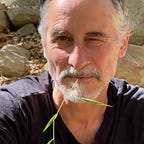AN EAST-WEST BRIDGE for Healing Trauma
A common notion is that spiritual practice is at odds with emotional work. It certainly can be, but it doesn’t have to be.
Yoga and meditation, for example, are invaluable for body-centered psychotherapy because they confer body awareness, greater focus, increased sensitivity, and patience with discomfort. Each of these, and especially all together, are crucial for working through trauma and emotional wounding.
There’s a pivot in body-mind practice where, once we begin to clear the body and mind of blocks, we can a) continue to ascend or b) deepen into our body-mind and its locked away, backlogged pain.
This is the fork in the road where we can leverage a jewel of the East — yoga, Qi Gong, and meditation — and join it with a jewel of the West — depth psychology. This way, we turn body-mind practice into a deepening, compassionate human experience rather than disconnected spiritual bypassing.
Instead of either/or, we can create a both/and beautiful marriage of East and West, so that heart-centered, embodiment itself becomes a deeply fulfilling spiritual practice. This is integrative wisdom that bridges the chasm between traditional spiritual practice and compassionately being in the world.
Body-mind practices are also essential to depth work because they help relieve everyday stress, what I call “skimming off the top layer.” We simply don’t have access to deeper psychic material such as our core love wounds when we are distracted and flooded with superficial daily stress. I’ve in fact heard many report that after dipping into their wounds, they realize they created a busy and hectic lifestyle precisely to avoid dealing with the unconscious trauma below it.
Once our awareness rests more fully in our bodies, and our bodies become more unblocked and enlivened—what I call embodied mind and awakened body—the deeper work can unfold. So, when people ask me what they can do to begin to heal trauma, I recommend body-mind practices. But not to take on all the spiritual woo baggage.
Once we begin to unlock the core wounds in our body-mind, our consciousness naturally expands, in a grounded, embodied way — because we started in the body and when it came time to go to the next level, we choose going further into the body instead of into the ethers. This is why embodied spirituality begins in the body and ends in the body, including that of the world.
Expansion upward takes care of itself once the historical damage is cleared enough. In my experience, that upwelling of joy soon becomes more horizontal than vertical, because compassion bends the excitement, joy, and passion that emerge from clearing emotional blocks into a horizontal vector of giving. If you think about it, this is compassion: a lateral connection and giving to others. And this laterality also reflects the marriage of East-West, up-down polarities: the horizontal golden thread of connection between you, others, and the Earth.
Compassion governs the calling of purpose and service because deep compassion and a passion to heal are what we practiced, cultivated, and were then rewarded with, from successfully entering the crucible to heal our own heart-hurts.
This way, we fill our own cup and create an overflow of embodied presence and care to others. We have freed ourselves to be resourced enough to give to others. This is how selfishness (healthy, sustainable work on oneself) done well becomes selflessness (overflowing wisdom, joy, and care). And those that help us along (because we never free our embodied selves on our own) are usually those who travelled the path before us.
This is how emotional work becomes the spiritual work, how East and West can create a new iteration of spirituality that blows talk therapy out of the water and grounds Eastern traditions in interpersonal and environmental justice through lateral compassion.
